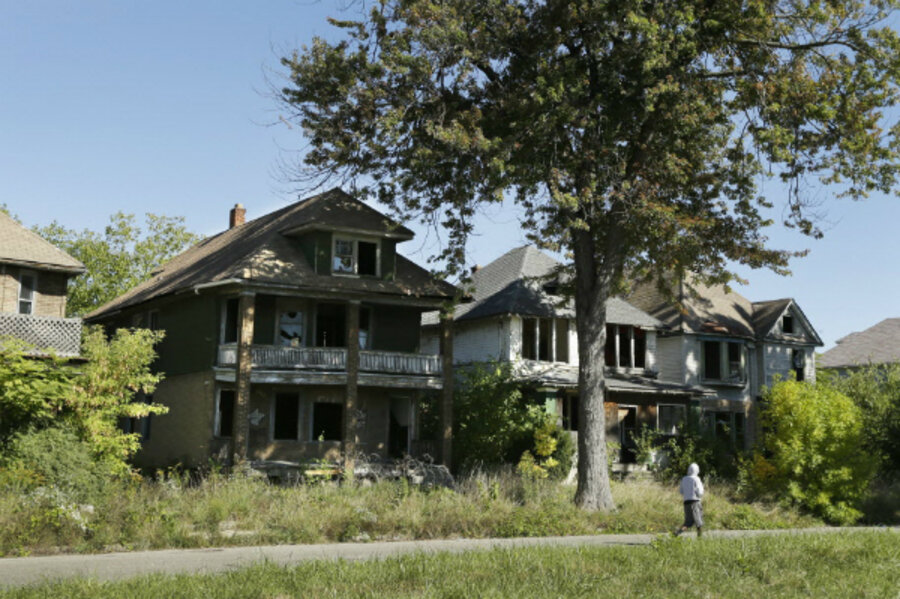US sending bankrupt Detroit $300 million. Think 'stimulus,' not 'bailout.'
Loading...
The Obama administration is pledging nearly $300 million in federal dollars to Detroit to help shore up basic infrastructure priorities, such as improving public transit and police and eradicating blight.
Just don’t call it a bailout – a term that's still toxic on Capitol Hill, on both sides of the aisle.
On July 18, Detroit became the largest US city ever to declare bankruptcy. It owes $18 billion, including $3.5 billion in underfunded pension liabilities and $5.7 billion in other retiree benefits.
The federal effort, announced after a summit in Detroit led by top Obama economic adviser Gene Sperling, doesn't begin to fill a fiscal hole that large, but aims instead to help meet the city's most immediate infrastructure needs.
“We do not think of it as our job to devise the priorities or the strategy for Detroit. Our job is to listen to all sectors of Detroit,” Mr. Sperling told reporters, after the closed meeting on Friday.
The summit included three Obama Cabinet officials – US Attorney General Eric Holder, Housing and Urban Development Secretary Shaun Donovan, and Transportation Secretary Anthony Foxx – along with state-appointed Emergency Financial Manager Kevyn Orr, Michigan Gov. Rick Snyder (R), Detroit Mayor Dave Bing (D), and other state and local officials.
The allocation of federal funds resulted from weeks of meetings with the city to determine where help might be needed most, Sperling said.
Before Mr. Orr petitioned the courts to declare a Chapter 9 bankruptcy for the city, a common cry among residents, and some in the city council, was for the federal government to provide a bailout to save Detroit from the insurmountable weight of its debt. Some argued that the city was owed the spoils the federal government provided private sector companies in the automotive and banking industries in its 2009 bailouts.
That didn’t happen, nor will it, says Mark Skidmore, an economist at Michigan State University in East Lansing, Mich. The combined federal and private-sector dollars are not geared toward restructuring Detroit’s debt problem, nor is it their total sum anywhere near what would be needed to do so in the first place. The goal, Professor Skidmore says, is to recharge the city after years of hemorrhaging money that led to failing infrastructure and a blight problem that has created dangerous public safety hazards.
“It’s not big enough to be called a bailout. What they are trying to do is enable key investments that are needed to help the city once it emerges from all of these immediate [financial] challenges,” he says. “It becomes much more difficult to do the things a city is required to do without those kinds of investments and reinvestments, so it seems like a sensible thing for the federal government to step in and assist.”
In speaking to the Detroit News Friday, Governor Snyder also reiterated that he was against a federal bailout for the city.
“What I said [in the past] is I wasn’t going to ask for a bailout on the debt. I think it’s always appropriate to say there are ways to improve services to citizens, because that’s one of the roles of government. It needs to be something that has a reasonable return because I don’t believe in wasting money, too,” he said.
A better comparison to the federal relief effort for Detroit, Skidmore says, is the stimulus money the Obama administration transferred to states and localities during the recession. The greatest amount, $145 billion in 2009, was used for states to fill their budget gaps and provide much-needed infrastructure dollars for transportation and education programs. That year, state tax revenues were 17 percent below what they were the previous year.
“If you think about what the government did for the states in the midst of the recession, they infused them with billions of dollars in order to keep state budgets from taking the turn for the worst. So it’s not unprecedented at all for the federal government to provide assistance in this way,” he says.
The new infusion of federal dollars doubles the nearly $300 million Detroit already receives annually from 71 separate federal grants ranging from policing to transportation. Local corporate and support from organizations including the Ford, Kresge, and Knight foundations, will match much of these new funds. Federal agencies are also planning to work on behalf of the city: For example, Detroit’s public lighting authority will partner with the US Department of Energy and DTE Energy to address technical support of the city’s ailing street lighting system.
A third of the new federal fund money, $100 million, is designed for blight eradication, which follows Mayor Bing’s plan to tear down 10,000 abandoned residential and commercial structures by the end of his term. About $30 million will be directed to repair city buses and boost the regional transit network. Other funds will be used for rail projects, police department training, anti-violence programs, the hiring of 150 firefighters, and public safety programs.








